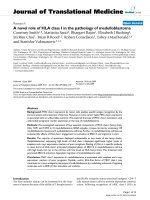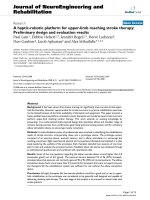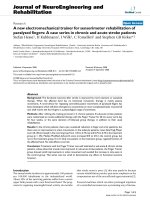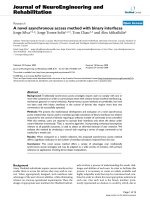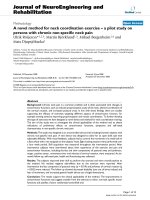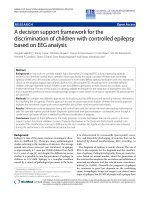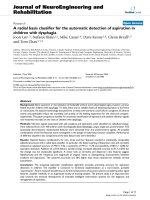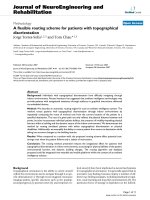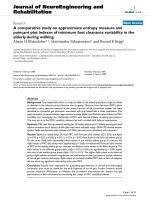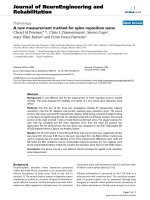Báo cáo hóa học: " A novel cloning strategy for isolating, genotyping and phenotyping genetic variants of geminiviruses" pdf
Bạn đang xem bản rút gọn của tài liệu. Xem và tải ngay bản đầy đủ của tài liệu tại đây (306.79 KB, 10 trang )
BioMed Central
Page 1 of 10
(page number not for citation purposes)
Virology Journal
Open Access
Methodology
A novel cloning strategy for isolating, genotyping and phenotyping
genetic variants of geminiviruses
Cica Urbino*
1
, Gael Thébaud
2
, Martine Granier
1
, Stéphane Blanc
2
and
Michel Peterschmitt
1
Address:
1
CIRAD-UMR BGPI, F-34398 Montpellier, France and
2
INRA-UMR BGPI, F-34398 Montpellier, France
Email: Cica Urbino* - ; Gael Thébaud - ; Martine Granier - ;
Stéphane Blanc - ; Michel Peterschmitt -
* Corresponding author
Abstract
Background: Viruses of the genus Begomovirus (Geminiviridae) are emerging economically
important plant viruses with a circular, single-stranded DNA genome. Previous studies have shown
that geminiviruses and RNA viruses exhibit similar mutation frequencies, although geminiviruses
are replicated by host DNA polymerases and RNA viruses by their own virus-encoded error-prone
RNA-dependent RNA-polymerase. However, the phenotypic effects of naturally occurring
mutations have never been extensively investigated in geminiviruses, particularly because, to be
infectious, cloned viral genomes usually require sub-cloning as complete or partial tandem repeats
into a binary vector from Agrobacterium tumefaciens.
Results: Using Tomato yellow leaf curl virus (TYLCV), we show here that infectivity can be obtained
when only a 41-nucleotide region containing a highly conserved stem-loop is repeated. A binary
vector containing this 41-nt region and a unique restriction site was created, allowing direct cloning
of infectious monomeric viral genomes provided that they harbour the same restriction site at the
corresponding nucleotide position. This experimental system, which can be transferable to other
geminiviruses, was validated by analysis of the phenotypic effect of mutations appearing in TYLCV
genomes in a single tomato host plant originally inoculated with a unique viral sequence. Fourteen
full-length infectious genomes extracted from this plant were directly cloned and sequenced. The
mutation frequency was 1.38 × 10
-4
mutation per nucleotide sequenced, similar to that found
previously for another begomovirus by sequencing PCR-amplified partial sequences. Interestingly,
even in this minimal pool of analysed genomes, mutants with altered properties were readily
identified, one of them being fitter and reducing plant biomass more drastically than the parental
clone.
Conclusion: The cloning strategy presented here is useful for any extensive phenotyping of
geminivirus variants and particularly of artificially generated mutants or recombinants.
Published: 31 October 2008
Virology Journal 2008, 5:135 doi:10.1186/1743-422X-5-135
Received: 25 September 2008
Accepted: 31 October 2008
This article is available from: />© 2008 Urbino et al; licensee BioMed Central Ltd.
This is an Open Access article distributed under the terms of the Creative Commons Attribution License ( />),
which permits unrestricted use, distribution, and reproduction in any medium, provided the original work is properly cited.
Virology Journal 2008, 5:135 />Page 2 of 10
(page number not for citation purposes)
Background
Host plant resistance is a major component of integrated
pest management (IPM) strategies for the control of virus
epidemics; however, its sustainability is often limited by
the emergence of resistance-breaking viral strains. The fre-
quency with which such events arise depends among oth-
ers, on two factors: (i) the error rate of the polymerase
with which the viral genome is replicated, and (ii) the per-
centage of mutations with a positive impact on fitness
and/or negative effect on crop production.
The error rate of the RNA-dependent RNA polymerases
encoded by RNA viruses has been estimated at 10
-4
–10
-5
misincorporation per nucleotide per replication round
[1,2]. Small ssDNA viruses, like the parvoviruses of mam-
mals (family Parvoviridae) and geminiviruses of plants
(family Geminiviridae), do not encode their own replicase.
Instead, they rely on host DNA polymerases; the rate of
errors occurring during replication of these viral genomes
is not known. However, the frequency of mutations
(number of mutations relative to the consensus, divided
by the number of nucleotides sequenced) as well as the
substitution rate per year investigated in isolates of gemi-
niviruses [3-5] were found to be of the same order of mag-
nitude as that of RNA viruses. Therefore, it was assumed
that the rate of errors generated during the replication of
ssDNA genomes was probably higher than the error rate
expected for host DNA polymerases. While the distribu-
tion of the effect of mutations on viral fitness has been
reported for one animal RNA virus [6] and one plant RNA
virus [7], thus far no data are available for any ssDNA
virus. Furthermore, the distribution and extent of the
effect of naturally occurring mutations on virulence has
never been investigated in any virus of eukaryotes.
Tomato yellow leaf curl virus (TYLCV) is responsible for one
of the most damaging begomovirus diseases occurring
worldwide [8]. TYLCV was initially described in Israel [9]
but is now present in Europe, South East Asia, America
and throughout the southern hemisphere. The genome of
TYLCV is composed of a small circular ssDNA of 2.79 kb.
A mutation frequency of about 3.1–4.1 × 10
-4
was recently
determined for a distantly related begomovirus from
China, Tomato yellow leaf curl China virus (TYLCCNV), in
viral populations extracted from individual Nicotiana
benthamiana and tomato (Solanum lycopersicum) plants
[3]. In this latter study, estimation of the mutation fre-
quency was based on the analysis of numerous PCR-
amplified DNA molecules, corresponding to 50% of the
viral genome. Although efficient for quantifying mutation
frequency, this approach does not allow further investiga-
tion of the phenotypic effect of the detected mutation (i.e.
fitness and virulence). Indeed, no full-length genomes
were analyzed in this particular case, and anyway, the full-
length genomes of most geminiviruses are not readily
infectious unless using a time consuming construction
process.
Although excised monomeric unit length DNA or cloned
DNA were found to be infectious for some begomoviruses
[10,11] infectivity of most geminivirus genomes can be
obtained only if they are delivered to the plant as a full- or
partial-length repeat and preferentially by Agrobacterium
tumefaciens within the T-DNA of a binary vector [12].
Using this technique – commonly known as agroinocula-
tion – it was shown with Beet curly top virus, a geminivirus
of the genus Curtovirus, that recovery of a functional circu-
lar viral genome was realised preferentially through repli-
cational release between the repeated origins of
replication rather than by homologous recombination
[13]. Thereafter, the origin of replication was mapped to a
nonanucleotide -TAATATTAC- highly conserved among
geminiviruses at the top of a stem-loop structure (SL) of
less than 50 nucleotides [14,15]. Taken together these
reports suggested that a construction in which the
repeated region would be limited to the SL should be
infectious. As the nucleotide sequence of the SL is also
highly conserved and particularly among begomoviruses,
we hypothesised that a binary vector containing only the
SL could be used for isolating, genotyping and phenotyp-
ing genetic variants of geminiviruses for intra-population
studies and experimental evolution.
The present report describes the development of such an
experimental system for TYLCV that is easily transferable
also to other geminiviruses. The repeated part of the
genome generally required for infectivity was trimmed
down to a 41-nucleotide fragment containing the SL of
TYLCV (33 nucleotides) inserted together with a unique
restriction site into a binary vector. An identical restriction
site was inserted at the corresponding position in an infec-
tious clone of TYLCV, so that all offspring genomes would
be directly clonable in this binary vector and readily infec-
tious upon agro-inoculation with no further manipula-
tion. The value of this system was proved by cloning,
sequencing, and characterising the fitness and virulence
(here defined as the impact on plant growth) of offspring
mutant genomes extracted from an infected plant: we
demonstrate the rapid appearance of mutants with
enhanced fitness and/or virulence, and moreover we
experimentally confirm an elevated mutation frequency
for TYLCV.
Results
Infectivity of a 1.01 mer TYLCV genome
The binary plasmid containing the 1.01 mer TYLCV
genome (p1.01TYLC, see methods) was agroinoculated
into tomato plants. Three weeks later, the inoculated
plants exhibited typical symptoms of yellow leaf curl and
stunting similar to those observed with plants agroinocu-
Virology Journal 2008, 5:135 />Page 3 of 10
(page number not for citation purposes)
lated with the tandemly repeated TYLCV-Mld-NotI
genome or wild type TYLCV-Mld. Agroinoculation with
plasmid pGreen-SL-NotI alone (i.e. with only the 41-nt SL
region of TYLCV) produced no symptoms. Thirty-six days
after agroinoculation with p1.01TYLC, total DNA was
extracted from 10 g of the youngest part of a single symp-
tomatic infected tomato plant. This DNA reacted posi-
tively with a TYLCV-Mld-specific probe in Southern blot
analysis (data not shown), indicating that the virus had
replicated and systemically infected the tomato plant.
This result showed that a very small repeated region of 41
bp, corresponding to the stem- loop structure containing
the origin of replication of begomoviruses, is sufficient to
allow the release of infectious genomes and further sys-
temic host invasion. As the vector plasmid pGreen-SL-
NotI constitutively contains this region, TYLCV genomes
with the engineered NotI site could be extracted from the
infected plant, and cloned directly back into this vector
plasmid in a readily infectious form. To validate this
experimental system, we obtained 14 full-length inser-
tions of the viral genome which were fully sequenced.
Mutant clones were analysed for fitness and virulence.
Mutation frequency
Sequence analysis of the 14 full-length genomes cloned
from the tomato plant initially agroinfected with
p1.01TYLC revealed that 6 clones differed from the paren-
tal sequence either through single substitutions (5 clones)
or an insertion (1 clone). A total of 5 mutations were
detected throughout the genome (Fig. 1): two non-synon-
ymous mutations in the coat protein gene (AV1), one in
the replication associated protein gene (AC1), one synon-
ymous mutation in the replication enhancer protein gene
(AC3), and one single insertion in the intergenic region
(IR). The AV1 mutation at position 785 was detected in
two distinct clones which exhibited 100% nucleotide
identity. It is possible that these two clones did not appear
independently; therefore this mutant was considered only
once in the calculation of the mutation frequency which
was thus derived from 13 full-length genomes and was
1.38 × 10
-4
mutation per nucleotide sequenced.
Phenotypic effect of mutations
The IR-, AC1- and AC3-mutants, and one of the AV1-
mutants were tested. For each mutant, virus accumulation
and its effect on the total dry weight of the infected plants
were compared with the parental cloned virus p1.01TYLC.
Of 20 tomato plants agroinoculated per clone, 12–14
Schematic representation of the infectious construct p1.01TYLC and position of mutations detected in the progenyFigure 1
Schematic representation of the infectious construct p1.01TYLC and position of mutations detected in the
progeny. The schema represents TYLCV-Mild-NotI cloned in the binary plasmid vector pGreen, The hatched boxes repre-
sent the vector; white boxes represent the intergenic region of TYLCV-Mld-NotI, and the white horizontal arrows represent
viral genes as indicated. The stem loop, including the NotI cloning site, is represented by a vertical bar topped by a white circle.
Vertical arrows and associated numbers indicate the position of the mutations detected in the progeny full-length clones.
Changes in nucleotide and amino acid sequences detected at the positions indicated are shown below the scheme (original/
mutated).
A
C3
1
2791
77 785 1053
1102
2095
A
V2
A
V1
A
C2
AC4
A
C1
Mutation A/G A/G A/G G/T
Insertion T
Change in M/V R/H no change P/H
amino acid
Virology Journal 2008, 5:135 />Page 4 of 10
(page number not for citation purposes)
plants were found to be infected for each clone. All the
mutants produced typical yellow leaf curl and stunting
symptoms between 17 and 34 days after agroinoculation.
Overall, the type of clone had a significant effect on dry
weight (p = 7 × 10
-4
), with the mean dry weight of the
plants infected with the IR-mutant being significantly
lower (p = 0.03) than the mean dry weight of the parental
clone (Fig. 2A); no significant deviations from parental
clone were recorded with other mutants. The type of clone
also had a significant effect on virus accumulation
Biological properties of TYLCV-Mild-NotI and four mutant clones in tomato plantsFigure 2
Biological properties of TYLCV-Mild-NotI and four mutant clones in tomato plants. Boxplots were obtained from
12 to 14 tomato plants per clone (A) Plant biomass 60 days after inoculation; (B), (C) and (D) Virus quantification normalised
to actin2 [log of the ratio of the number of viral copies to that of actin2] 15, 25 and 35 days after inoculation, respectively. Each
boxplot shows the median (horizontal line), first and third quartiles (lower and upper limits of boxes), and the minimum and
maximum values (delimited by the external whiskers). *: Significant at p = 0.05; **: Significant at p = 0.01.
(A) Plant biomass
0
2
4
6
8
10
12
14
16
AV1-M
AC1-M
p1.01TYLCV
IR-M*
AC3-M
dry weight of plan
t
(B) 15 days post inoculation
-2
-1
0
1
2
3
4
AV1-M
AC1-M
p1.01TYLCV
IR-M*
AC3-M
log of ratio (virus/actin
)
(C) 25 days post inoculation
-1
0
1
2
3
4
5
AV1-M
AC1-M
p1.01TYLCV
IR-M
AC3-M
log ratio (virus/actin)
(D) 35 days post inoculation
0
1
2
3
4
5
AV1-M
AC1-M**
p1.01TYLCV
IR-M
AC3-M**
log ratio (virus/actin)
Virology Journal 2008, 5:135 />Page 5 of 10
(page number not for citation purposes)
(increasing with time from p = 0.05 to p = 8 × 10
-12
), with
the AC3-mutant accumulating more vDNA than the
parental clone at 15 and 25 days (p = 0.08 and p = 0.07,
respectively; Figs. 2 and 3) and significantly more at 35
days after inoculation (p = 3 × 10
-5
). The IR-mutant accu-
mulated significantly more vDNA at 15 days after inocu-
lation (p = 0.032, Fig. 2B) but was not significantly
different at the other time points. The AC1-mutant accu-
mulated significantly less virus at 35 days after inocula-
tion (p = 2 × 10
-4
, Fig. 2D, Fig. 3). No clear correlation
could be found between virus accumulation and its effect
on the dry weight of the corresponding plant.
Discussion
Most infectious clones of geminiviruses consist of cloned
(partial) tandem repeats of viral genomes, which usually
involved tedious, multi-step assemblies of genomic frag-
ments in the construction process. Recently, two groups
have reported a simplified cloning strategy of agroinfec-
tious tandem repeats but which only applies to mul-
timeric viral genomes obtained by rolling circle
amplification (RCA) using Phi29 DNA polymerase
[16,17]. The novel cloning strategy presented here is not
only applicable to RCA, but also to PCR amplified
genomes or even to replicative forms of the genome
directly extracted from infected plants if amplification
step is not required or has to be avoided. This will be par-
ticularly useful for artificially produced recombinants or
mutants derived from already cloned monomeric viral
genomes.
Based on the traditional technique of partial tandem
repeats, we show that infectivity is maintained even when
the repeated region was limited to the 41-nucleotide
highly conserved stem-loop region of geminiviruses.
Moreover, we showed that a binary vector containing this
41-nt region and a unique restriction site can be used to
clone infectious monomeric viral genomes provided that
they harbour the same restriction site at the corresponding
nucleotide position. As previously suggested with longer
repeated fragments containing the stem-loop region of
two other geminivirus species, the infectivity obtained
here is consistent with the mechanism of replicational
release [13,14]. Indeed, in our constructs, homologous
recombination would only be rarely possible within the
tiny 41-nt repeat, which would engender greatly reduced
infection success. Thus, it is assumed that the only region
of pGreen-SL-NotI vector which is released with the infec-
tious full length genomes is located between the origin of
replication and the position of the created cloning site
(Fig. 4A). As this released region is identical in about 70%
of begomoviruses (comparison with genomic sequences
of one member of each of 70 begomovirus species repre-
sentative of the world diversity,[18]), pGreen-SL-NotI
could be used for a large range of begomoviruses provided
that NotI is also engineered at the corresponding position
of the genomes.
The latent period between inoculation and typical leaf
curl observation was similar with both p1.01TYLCV and
the tandem construction of TYLCV-Mld-NotI in the binary
vector pCambia 2300, but the infection rate was lower
with p1.01TYLCV (40% versus 80–90%, data not shown).
It cannot be excluded that the lower infection rate was due
to the limited repeated region. However with an identical
construction in which the cloning site NotI was replaced
by XhoI, and the pGreen plasmid was replaced by the
binary vector pCambia380, we obtained 90% efficiency of
agroinoculation (not shown) suggesting that the reduced
length of the repeated region may not necessarily be the
reason for the lower infection rate observed with
p1.01TYLCV. The restriction sites, either NotI or XhoI,
were engineered in a variable region of begomovirus
genomes which tolerates mutations without loss of infec-
tivity. The use of an alternative restriction site (here XhoI)
may be useful for viral species where a NotI site already
Average virus accumulation of TYLCV-Mild-NotI and four mutant clones in tomato plantsFigure 3
Average virus accumulation of TYLCV-Mild-NotI and
four mutant clones in tomato plants. Data were
obtained from 12 to 14 infected plants per clone. TYLCV-
Mild-NotI (black triangle with bold line), AC3-M (red circle),
IR-M (yellow square), AC1-M (blue square), IR-M (green tri-
angle). Vertical bars around each point represent the 95%
confidence interval.
Kinetics of virus accumulation
in tomato plants
0
1
2
3
4
10 15 20 25 30 35 40
days after inoculation
mean log of ratio (virus/actin
)
Virology Journal 2008, 5:135 />Page 6 of 10
(page number not for citation purposes)
exists in the wild type genome. Besides the advantage of
directly cloning infectious full-length genomes of a gemi-
nivirus, the fact that the cloning site is only 15 nucleotides
downstream of the origin of replication contributes to the
exclusive cloning of replicable DNAs.
The usefulness of this novel cloning strategy was further
demonstrated by showing that not only are TYLCV
mutants generated at high rate within 36 days in a tomato
plant (5 mutants in 13 clones), but also that they exhibit
altered biological properties: some of these mutants accu-
mulating more viral DNA and reducing plant growth
more drastically than the progenitor clone. Although this
does not represent an exhaustive evaluation of the life
traits of the virus, our results suggest that TYLCV mutants
with both increased fitness and virulence can appear at a
very fast pace, even during a single host infection cycle.
The mutation frequency estimated 36 days after plant
inoculation on 13 directly cloned full-length TYLCV DNA
genomes (thus precluding any possible PCR amplification
artefacts), was 1.38 × 10
-4
. This frequency is in the same
order of magnitude as that determined recently [3] with
another tomato begomovirus (TYLCCNV). In this earlier
study, the authors reported a mutation frequency of 3.1–
4.1 × 10
-4
at 60 days after infection and of 5.3 × 10
-4
at 120
days after infection. The experiment reported here on
TYLCV was terminated 36 days after inoculation, i.e. a
shorter infection period, which could explain the slightly
but significantly lower mutation frequency (p = 0.032, t-
test) compared to the 60-day results of TYLCCNV, possi-
bly due to the reduced number of generations. The higher
mutation frequency of TYLCCNV [3] may also be
explained by (i) the fact that sequencing was not per-
formed on full-length genomes, but on a selected region
containing highly variable sequence stretches such as IR
and AC1/AC4; (ii) an intrinsic property of the virus; and
(iii) to some extent, to the fact that viral sequences were
not directly extracted and cloned from infected plants, but
first amplified by PCR, which introduces additional muta-
tions at a frequency estimated at around 4.9 × 10
-5
[3].
Nevertheless, the results presented here for TYLCV further
support a growing body of evidence [2-5,19] paradoxi-
cally suggesting a similar mutation frequency in ssDNA
viruses and RNA viruses, the former being replicated by
supposedly faithful host DNA-polymerases, and the latter
by error-prone RNA-dependent RNA-polymerases. This
paradox remains unexplained but it has been proposed
that the mismatch repair machinery, and/or proof reading
Construction of pGreen-SL-NotIFigure 4
Construction of pGreen-SL-NotI. (A) Site-directed mutagenesis at the end of the stem loop to generate a NotI site in the
TYLCV-Mld clone. The underlined bold A nucleotide in the loop indicates the origin of replication. (B) Oligonucleotide
sequence used to insert the stem loop shown in (A) in the multiple cloning site of the vector pGreen.
(A)
A T A
A T
T T
A A
T C (B)
G C
C G
G/GATCCAAGCGGTCATCCGTATAATATTACCGGATGGCCGC/GGCCGCAAAAGAGCT/C
C G BamHI NotI SacI
T A
A T
C G
T G
G C
G C
C G
AAG CGCCTTTTCCT original viral sequence
CGGCCGCTCCT
after site-directed muta
g
enesis
Virology Journal 2008, 5:135 />Page 7 of 10
(page number not for citation purposes)
activity of DNA-polymerases may not function with the
geminivirus genome as it does with cellular DNA [20,21].
Confirmation of this hypothesis lacks important informa-
tion from both the plant and the virus side. On the one
hand, the DNA-polymerase used by ssDNA viruses for
replication has not been identified, thus precluding any
estimate of its intrinsic error rate. On the other hand, the
generation time of ssDNA viruses is not known, again rul-
ing out a formal estimate of the error rate (per nucleotide,
per replication round) of the plant polymerase hijacked
for virus replication.
After only 36 days of infection, 3 mutant clones exhibiting
a phenotype distinct from the parental clone were
obtained. To our knowledge, none of the modified posi-
tions of the genome have been specifically described in
the literature to be involved in molecular interaction at
the DNA or protein level. Therefore we can only speculate
that the known functions or interactions of the genes and
IR promoters in which the insertion and mutations
occurred were somehow modified. For example, the
higher fitness induced by the single insertion in the IR
could be explained by its modified interaction with the
transcription activator protein encoded by AC2 [22]. The
synonymous mutation in the AC3 gene, which induced
significantly higher fitness, could be explained by a higher
stability of the mRNA of AC3, which encodes a replication
enhancer protein [23]. The AC1 non-synonymous muta-
tion is located in the region of the gene encoding the oli-
gomerisation domain of the Rep protein, which is
essential for viral replication, perhaps suggesting modifi-
cation of the oligomeric state of this protein [24].
Although no evident correlation was detected between fit-
ness (virus accumulation) and virulence (as estimated by
the effect on the dry weight of the host plant), the data
obtained with the IR mutant indicate that increased accu-
mulation of the virus at the early stage of infection may be
damaging for the plant, even if final accumulation levels
are unchanged.
Conclusion
The novel cloning system presented here will be useful for
any study in which extensive phenotyping of geminivi-
ruses is required. As illustrated in this paper, it can be used
for experimental evolution in planta. The technological
bottleneck is no longer the time-consuming construction
of infectious (partial) tandem clones, but rather the
extraction of sufficient amounts of vDNA, particularly for
those geminiviruses, such as TYLCV, which accumulate at
low concentration in plants. More interestingly the novel
cloning strategy will be useful to allow the high through-
put phenotyping of artificially generated mutants, as ear-
lier performed in other viral genera [6,7], or even of
artificially generated recombinants.
Methods
Viral clone and vector plasmid to create agroinfectious
unit length viral genomes
A full-length genome of a Réunion isolate of the Mild
strain of Tomato yellow leaf curl virus (TYLCV-Mld, acces-
sion no. AJ865337
[25]) previously cloned into a pGEM-T
Easy vector, was used in this study. A unique NotI restric-
tion site was created by site-directed mutagenesis (Quik-
Change
®
II XL Site-Directed Mutagenesis Kit, Stratagene)
at the 3'-end of the conserved stem-loop sequence of the
TYLCV-Mld genome (Fig. 4A), generating a clone named
pTYLCV-Mld-NotI. The full-length viral genome was
released from this plasmid vector by BamHI restriction
[25], and subsequently religated to generate circular
closed single copies of the TYLCV-Mld-NotI genome.
The binary high-copy plasmid vector pGreen [26]http://
www.pgreen.ac.uk was modified as follows: a 41-bp
dsDNA fragment, encompassing the conserved stem-loop
(SL) of begomoviruses, and including a NotI site at the
same nucleotide position as that described above in
TYLCV-Mld, was prepared by hybridisation of two com-
plementary oligonucleotides (Fig. 4B). These oligonucle-
otides were designed to generate cohesive ends for cloning
into the BamHI and SacI restriction sites of the pGreen
vector, thus generating pGreen-SL-NotI. Single copies of
the TYLCV-Mld-NotI genome (see above) were linearised
at the engineered NotI site and cloned into pGreen-SL-
NotI, resulting in a 1.01-mer genome. After checking for
the sense orientation of the inserted genome, a recom-
binant plasmid was selected and is referred to as
p1.01TYLC (Fig. 1). This plasmid was finally purified
from E. coli DH5-α, used for all cloning steps, and intro-
duced into A. tumefaciens C58 MP90 by electroporation.
Transformed A. tumefaciens colonies were plated and cul-
tivated at 28°C on LB medium containing kanamycin and
gentamycin, and used for agroinoculation as described
below.
Plant inoculation
Tomato plants cv. Nainemor were inoculated at the two-
leaf stage by pricking the stem three times at different lev-
els with the tip of an 18 Gauge ×1 1/2 needle previously
dipped into a 24 h-plated culture of A. tumefaciens carry-
ing p1.01TYLC or derivatives. Plants were maintained in
an insect-free containment chamber at 26°C with a 16 h
photoperiod. As a negative control, plants were inocu-
lated with A. tumefaciens carrying the empty pGreen-SL-
NotI plasmid.
Extraction of viral DNA
Ten grams of leaf and stem material were collected from
the youngest part of a tomato plant 36 days after agroin-
oculation with p1.01TYLC. Total DNA was extracted with
the Midi DNeasy plant DNA extraction kit (Qiagen). DNA
Virology Journal 2008, 5:135 />Page 8 of 10
(page number not for citation purposes)
was eluted in 20 ml of water, and concentrated down to a
volume of 500 μl by drying under vacuum for 3–4 h. To
eliminate high molecular weight plant DNA, the 1–6 kb
DNA fraction containing all the viral DNA forms (vDNA)
according to Southern blot assay, was purified from a 1%
agarose gel (SV Wizard Gel kit, Promega) and eluted in 80
μl of water. The gel-purified DNA was digested with NotI,
microdialysed to eliminate buffer salts, and subsequently
used for cloning. The presence of NotI-linearised full-
length viral genomes was verified by Southern blotting
and probing with a digoxygenin-labelled full-length
TYLCV-Mld genome using a DIG-High Prime DNA Label-
ling and Detection Starter kit (Roche Diagnostics). Posi-
tive signals on membranes were revealed with the
chemiluminescent substrate CDP star (Roche Diagnos-
tics).
Cloning of viral progeny
A 7.5 μl NotI-digested vDNA sample was mixed with 300
pg of dephosphorylated NotI digested pGreen-SL-NotI
plasmid for a 24 h ligation reaction at 4°C in a final vol-
ume of 10 μl. An aliquot of 4 μl of this ligation mixture
was then electroporated into 35 μl suspensions of electro-
competent XL1 Blue bacteria (Stratagene) according to the
supplier's protocol.
Bacterial colonies were prepared for colony hybridisation
with a full-length digoxygenin-labelled TYLCV-Mld
genome as described in Sambrook et al. [27] and positive
signals were revealed as described above. Recombinant
plasmids obtained from positive hybridising colonies
were digested with NotI to detect the presence and size of
inserts on agarose gels, and with BamHI to determine the
orientation of the insertion.
Sequence determination and analysis
Samples of cloned vDNA were sequenced (Genome
Express) with four TYLCV-specific primers and two
pGreen-specific primers (Table 1). Sequence data were
assembled and analyzed with DNAMAN software (ver-
sion 5.0, Lynnon BioSoft). The mutation frequency was
calculated as the number of mutations relative to the
parental clone, divided by the number of nucleotides
sequenced.
Phenotypic effect of mutations
Four TYLCV mutant clones, the parental clone p1.01TYLC
and the vector pGreen-SL-NotI were each agroinoculated
to 20 tomato plants. Prior to agroinoculation, mutant
clones that were found to be inserted in the negative sense
orientation were released with NotI and re-inserted in the
opposite orientation in pGreen-SL-NotI. Plants were
maintained in an insect-free containment chamber at
26°C with a 16 h photoperiod. They were randomly dis-
tributed in 5 blocks containing each 4 inoculated plants
per treatment. Symptoms were monitored visually twice a
week from 14 to 60 days after agroinoculation.
Table 1: Primers for detection of TYLCV in infected plants, sequencing of TYLCV clones, and relative quantification of TYLCV with
quantitative PCR (Q-PCR)
Primer code Primer sequence Final concentration used
Detection of TYLCV with PCR (600 bp amplicon)
Ty 2353+ CTGAATGTTTGCATGGAAATGTGC 200 nM
Ty321- GGTCGCTTCGACATARTCACG 200 nM
Sequencing of TYLCV cloned sequences
pGreen1589 (+) CACGACGTTGTAAAACGACG
pG1825(-) CACAGGAAACAGCTATGACC
579 (+) GATGTTACTCGTGGATCTGG
1141 (+) CATGATCAACTGCTCTGATTAC
1741(+) GGGCTTCCCGTACTTTGTG
2321(+) TGGATTTAGCTCCCTGAATG
TYLCV primers for Q-PCR (176 bp amplicon)
Ty 2164+ CTAAGAGCCTCTGACTTACTGC 200 nM
Ty 2339- AACATTCAGGGAGCTAAATCCAG 200 nM
Actin2 gene primers for Q-PCR (148 bp amplicon)
Act 1+ CCCRGAGGTHCTCTTCCARC 200 nM
Act 148- TMCGRTCAGCAATACCAGGG 200 nM
Virology Journal 2008, 5:135 />Page 9 of 10
(page number not for citation purposes)
The youngest part of the tomato plant has previously been
shown to accumulate the highest titres of TYLCV DNA
[28], with no significant difference between the four
upper leaves [29]. Thus, virus accumulation was moni-
tored using quantitative PCR (Q-PCR) from a foliar disc of
1 cm diameter, collected from the top leaflet of the young-
est expanded leaf of each plant at 15, 25 and 35 days after
agroinoculation. Total DNA was extracted with the CTAB
method [30]. DNA was dissolved in 50 μl of ultrapure
water and stored at -20°C until use. Sixty days after inoc-
ulation, a leaf sample was collected from each asympto-
matic plants to test for the presence of virus by non-
quantitative PCR using primers Ty 2353+ and Ty321-
(Table 1). Thereafter, on the same day, all the plants were
cut at the level of the marks left by cotyledon leaves, dried
for 48 h at 60°C, then weighed. Although the reduction of
plant biomass was not shown to be a determinant of vir-
ulence for the TYLCV/tomato system, it was chosen in this
study to estimate the impact of the virus on the fitness of
the plant. Indeed, tomato is an annual cultivated plant for
which the plant growth has an impact on the yield and is
consequently more accurate than the number of viable
seeds to estimate the virulence of a viral clone.
Quantitative PCR conditions
Five microlitres of 1/100 diluted vDNA samples, extracted
as described above, were tested for each sample in a final
volume of 25 μl, using 96-well optical plates and the
Mx3005P
®
QPCR System (Stratagene). The reaction mix
was prepared with the qPCR core kit for SYBR Green I no
ROX (Eurogentec) according to the manufacturer's recom-
mendations. The primers designed for TYLCV DNA quan-
tification were Ty 2164+ and Ty 2339 The tomato actin2
gene was quantified in each extract to allow comparison
of vDNA accumulation between DNA extracts based on
the same number of plant cells per plant sample. Primers
targeting the actin2 gene (Act 1+/Act 148-) were derived
from the alignment of five actin2 sequences determined
from tomato plants of the cv. Nainemor and sequences
available in the GenBank database (Accession nos.
U60481
, BT013524, BT013707). The sequences and final
concentrations of primers are listed in Table 1.
Cycling parameters were 95°C for 10 min followed by 40
cycles of 15s at 95°C, 1 min at 66°C and 30s at 72°C. The
amount of specific product was monitored using the dye
SYBR Green I. Two replicates were amplified per sample.
Data obtained by Q-PCR were analyzed using MxProv4.
Accumulation of TYLCV in tomato plants
The number of DNA copies of TYLCV and derivatives was
assessed with a standard curve obtained with a serial ten-
fold dilution of the plasmid p1.01TYLC (8.45 × 10
3
–8.45
× 10
8
copies) in a 1/100 dilution of a mock-DNA extract
from healthy tomato plants. The number of actin2 gene
was assessed with a standard curve obtained with a serial
tenfold dilution of a plasmid containing a PCR-amplified
fragment (214 nt) of the actin2 gene (3.22 × 10
2
-3.22 ×
10
7
copies). Results were expressed as the log of the ratio
of the quantity of TYLCV to that of actin2.
Statistics
Dry weight and virus accumulation at 15, 25 and 35 days
after inoculation were compared using an ANOVA with
the R statistical software (R Development Core Team).
Competing interests
The authors declare that they have no competing interests.
Authors' contributions
CU carried out the virus extraction, cloning of progeny,
sequence analysis, phenotypic experimentations and
drafted the manuscript. GT performed the statistical anal-
ysis. MG carried out the plasmid and viral construction.
MP designed the molecular construction. SB and MP con-
ceived of, designed and coordinated the study, and helped
to draft the manuscript. All authors read and approved the
final manuscript.
References
1. Drake JW, Holland JJ: Mutation rates among RNA viruses. Proc
Natl Acad Sci USA 1999, 96:13910-13913.
2. Garcia-Arenal F, Fraile A, Malpica JM: Variability and genetic
structure of plant virus populations. Ann Rev Phytopathol 2001,
39:157-186.
3. Ge LM, Zhang JT, Zhou XP, Li HY: Genetic structure and popu-
lation variability of tomato yellow leaf curl China virus. Jour-
nal of Virology 2007, 81:5902-5907.
4. Isnard M, Granier M, Frutos R, Reynaud B, Peterschmitt M: Quasis-
pecies nature of three maize streak virus isolates obtained
through different modes of selection from a population used
to assess response to infection of maize cultivars. J Gen Virol
1998, 79:3091-3099.
5. Duffy S, Holmes EC: Phylogenetic evidence for rapid rates of
molecular evolution in the single stranded DNA begomovi-
rus Tomato yellow leaf curl virus. J Virol 2008, 82:957-965.
6. Sanjuán R, Moya A, Elena SF: The distribution of fitness effects
caused by single-nucleotide substitutions in an RNA virus.
Proc Natl Acad Sci USA 2004, 101:8396-8401.
7. de la Iglesia F, Elena SF: Fitness declines in Tobacco Etch Virus
upon serial bottleneck transfers. J Virol 2007, 81:4941-4947.
8. Czosnek H, Laterrot H: A worldwide survey of tomato yellow
leaf curl viruses. Arch Virol 1997, 142:1391-1406.
9. Czosnek H, Ber R, Antignus Y, Cohen S, Navot N, zamir D: Isolation
of tomato yellow leaf curl virus, a geminivirus. Phytopathology
1988, 78:508-512.
10. Bonilla-Ramirez GM, Guevara-Gonzales RG, Garzon-Tiznado JA,
Ascencio-Ibanez JT, Torres-Pacheco I, Rivera-Bustamante RF: Anal-
ysis of the infectivity of monomeric clones of pepper
huasteco virus. J Gen Virol 1997, 78:947-951.
11. Lapidot M, Weil G, Cohen L, Segev L, Gaba V: Biolistic inoculation
of plants with Tomato yellow virus DNA. J Virol Methods 2007,
144:
143-148.
12. Grimsley N, Hohn T, Davies JW, Hohn B: Agrobacterium -medi-
ated delivery of infectious maize streak virus into maize
plants. Nature 1987, 325:177-179.
13. Stenger DC, Revington GN, Stevenson MC, Bisaro DM: Replica-
tional release of geminivirus genomes from tandemly
repeated copies: Evidence for rolling-circle replication of a
plant viral DNA. Proc Natl Acad Sci U S A 1991, 88(18):8029-8033.
14. Heyraud F, Matzeit V, Schaefer S, Schell J, Gronenborn B: The con-
served nonanucleotide motif of the geminivirus stem-loop
Publish with BioMed Central and every
scientist can read your work free of charge
"BioMed Central will be the most significant development for
disseminating the results of biomedical research in our lifetime."
Sir Paul Nurse, Cancer Research UK
Your research papers will be:
available free of charge to the entire biomedical community
peer reviewed and published immediately upon acceptance
cited in PubMed and archived on PubMed Central
yours — you keep the copyright
Submit your manuscript here:
/>BioMedcentral
Virology Journal 2008, 5:135 />Page 10 of 10
(page number not for citation purposes)
sequence promotes replicational release of virus molecules
from redundant copies. Biochimie 1993, 75:605-615.
15. Stanley J: Analysis of African cassava mosaic virus recom-
binants suggests strand nicking occurs within the conserved
nonanucleotide motif during the initiation of rolling circle
DNA replication. Virology 1995, 206:707-712.
16. Ferreira PdT, Lemos TO, Nagata T, Inoue-Nagata AK: One step
cloning approach for construction of agroinfectious begomo-
virus clones. J Virol Methods 2008, 147:351-354.
17. Wu CY, Lai YC, Lin NS, Hsu YH, Tsai HT, Liao JY, Hu CC: A sim-
plified method of constructing infectious clones of begomo-
virus employing limited restriction enzyme digestion of
products of rolling circle amplification. J Virol Methods 2008,
147:355-359.
18. Fauquet CM, Briddon RW, Brown JK, Moriones E, Stanley J, Zerbini
M, Zhou X: Geminivirus strain demarcation and nomencla-
ture. Arch Virol 2008, 153:783-821.
19. Shackelton LA, Parrish CR, Truyen U, Holmes EC: High rate of
viral evolution associated with the emergence of carnivore
parvovirus. Proc Natl Acad Sci USA 2005, 102:379-384.
20. Brough CL, Gardiner WE, Inamdar NM, Zhang X-Y, Ehrlich M, Bisaro
DM: DNA methylation inhibits propagation of tomato golden
mosaic virus DNA in transfected protoplasts. Plant Mol Biol
1992, 18:703-712.
21. Inamdar NM, Zhang X-Y, Brough CL, Gardiner WE, Bisaro DM, Ehr-
lich M: Transfection of heteroduplexes containing uracil · gua-
nine or thymine · guanine mispairs into plant cells. Plant Mol
Biol 1992, 20:123-131.
22. Sunter G, Bisaro DM: Transactivation of geminivirus AR1 and
BR1 gene expression by the viral AL2 gene product occurs at
the level of transcription. Plant Cell 1992, 4:1321-1331.
23. Sunter G, Hartitz MD, Hormuzdi SG, Brough CL, Bisaro DM:
Genetic analysis of TGMV: ORF AL2 is required for coat pro-
tein accumulation while ORF AL3 is necessary for efficient
DNA replication. Virology 1990, 179:
69-77.
24. Clerot D, Bernardi F: DNA helicase activity is associated with
the replication initiator protein Rep of Tomato Yellow Leaf
Curl Geminivirus. J Virol 2006, 80:11322-11330.
25. Delatte H, Martin DP, Naze F, Goldbach R, Reynaud B, Peterschmitt
M, Lett JM: South West Indian Ocean islands tomato begomo-
virus populations represent a new major monopartite bego-
movirus group. J Gen Virol 2005, 86:1533-1542.
26. Hellens RP, Edwards EA, Leyland NR, Bean S, Mullineaux PM:
pGreen: a versatile and flexible binary Ti vector for Agrobac-
terium-mediated plant transformation. Plant Mol Biol 2000,
42:819-832.
27. Sambrook J, Fritsh EF, Maniatis T: Molecular cloning: A Laboratory Man-
ual Cold Spring Harbor, N.Y.: Cold spring Harbor Press; 1989.
28. Ber R, Navot N, Zamir D, Antignus Y, Cohen S, Czosnek H: Infec-
tion of tomato by the tomato yellow leaf curl virus: suscepti-
bility to infection, symptom development, and accumulation
of viral DNA. Arch Virol 1990, 112:169-180.
29. Mason G, Caciagli P, Accotto GP, Noris E: Real-time PCR for the
quantitation of Tomato yellow leaf curl Sardinia virus in
tomato plants and in Bemisia tabaci. J Virol Methods 2008,
147:282-289.
30. Doyle JJ, Doyle JL: Isolation of plant DNA from fresh tissue.
Focus 1990, 12:13-15.
